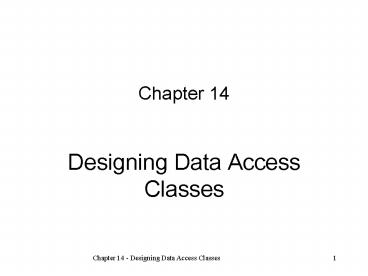Chapter 14 Designing Data Access Classes - PowerPoint PPT Presentation
1 / 29
Title:
Chapter 14 Designing Data Access Classes
Description:
It's a non-static method because it's invoked for the new customer being added ... Database is one or more files that help make queries ... – PowerPoint PPT presentation
Number of Views:44
Avg rating:3.0/5.0
Title: Chapter 14 Designing Data Access Classes
1
Chapter 14Designing Data Access Classes
2
Making Objects Persistent
- Use object persistence to store instances or
attribute values for later retrieval - Two approaches to achieving persistence
- Attribute storage store the objects attributes
individually - Object storage store the entire object
- Advantage of object storage is that you dont
need to recreate the object when you retrieve it
3
Making Objects Persistent
4
Designing a Data Access Class
- The purpose of the Data Access (DA) class is to
provide methods to store and retrieve data and
make instances of a Problem Domain (PD) class
persistence - Three tier OO design
- GUI class
- PD class for business entities
- DA class for data storage and retrieval
- DA class isolates data storage and retrieval
- DA class supports three-tier architecture
5
Data Access Methods
- Since you will not have instances of the DA class
all methods will be static - Four basic methods are provided
- Retrieve find method
- Store addNew method
- Change update method
- Remove delete method
6
Data Access Methods
7
Communicating with DA Class
14
- The Customer class invokes methods in CustomerDA
class - Isolates the DA class from everything but PD
class - DA class methods are not tied to data storage
method
8
Finding a Customer
14
- The purpose of the PD find method is to invoke
the DA find method - Its a static method because its not tied to a
specific customer instance - Throws a NotFoundException if the customer is not
found
9
Adding a Customer
- The purpose of the PD addNew method is to invoke
the DA addNew method - Its a non-static method because its invoked for
the new customer being added - Throws a DuplicateException if the customer
already exists
10
Changing a Customer
- The purpose of the PD update method is to invoke
the DA update method - Its a non-static method because its invoked for
the customer being updated - Throws a NotFoundException if the customer is not
found
11
Deleting a Customer
- The purpose of the PD delete method is to invoke
the DA delete method - Its a non-static method because its invoked for
the customer being deleted - Throws a NotFoundException if the customer is not
found
12
Understanding Java I/O
14
- Java views data input and output as a flow of
bytes - Two different data streams
- Byte stream
- Character stream
13
Understanding Java I/O
14
14
Understanding Java I/O
14
- Record is a collection of related variables
- File is a collection of related records
- Sequential files contains records that are stored
and processed in sequential order - Random access files are organized so you can
access a record by specifying its record number - Database is one or more files that help make
queries - Relational database organized in tables and rows
15
Implementing Persistence with a Sequential File
14
- Reads the customer records, creates a customer
instance for each record, and places instances in
a Vector - Uses the java.io package import java.io.
16
Initialize Method
14
- Reads the attribute values for all of the
customers from the sequential file - Uses BufferReader class to read the file
sequentially
17
Terminate Method
14
- Responsible for creating a file that contains
attribute values for all the customer instances
in the Vector - Attributes written to the file using the println
method
18
Find Method
- The find method simply iterates the customers
Vector, seeking a customer instance with a phone
number that matches the value received by the
method - If the customer is not found a NotFoundException
is thrown
19
AddNew Method
- Simply adds the new reference to the Vector
- If a duplicate is found throws a
DuplicateException error
20
Update Method
14
- Contains no code since the file is written when
done
21
Delete Method
14
- Remove a customer from the system
- Removes the reference from the Vector
- If the customer is not found a NotFoundException
is thrown
22
getAll Method
- The Vector already contains all of the customers
- Simply returns this Vector
23
Testing CustomerDA Class
14
- Create two customer instances
- Invoke initialize
- Invoke addNew to add two customers
- Retrieve reference to first customer
- Invoke getAll
- Invoke delete
- Change first customers address and verify
- Invoke the terminate method
24
Implementing Persistence with Random Access
- Change the file specification to Customer.ran
- Use the RandomAccessFile class
- Use the writeBytes method
25
Implementing Persistence with Object Serialization
- Store the entire Customer instances
- Change the file specification to Customer.obj
- Use the ObjectInputStream and the readObject
method - Use the ObjectOutputStream and the writeObject
method
26
Designing a Relational Database
14
- Provide tools to organize data into tables
- Each column represents a field
- Each row represents a record
- Each customer is identified by their phone number
primary key - Protocols required to access Microsoft Access
- Java Database Connectivity (JDBC)
- Open Database Connectivity (ODBC)
27
Designing a Relational Database
14
28
Understanding SQL
14
- Structured Query Language (SQL) used to access
relational databases - SQL SELECT is used to retrieve a specific
customer record - SQL INSERT is used to add a new customer record
- SQL UPDATE is used to change a customer record
- SQLQ DELETE is used to delete a customer record
- Java.sql package contains the database access
method
29
Understanding SQL
14































